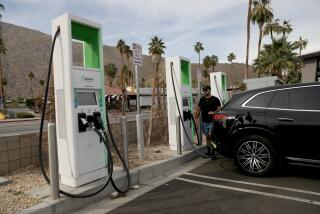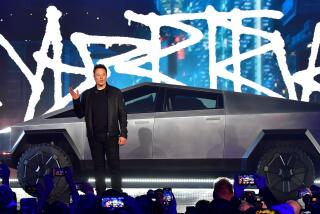GM chairman: ‘It’s our intention to get profitable’
The new chairman of General Motors Co. drove the much-anticipated Chevy Volt plug-in hybrid prototype for the first time Tuesday. The next day, the federal government put up nearly $400 million to help him build it.
After the first board meeting of the reborn, privately held GM, Edward E. Whitacre Jr. emphasized the company’s commitment to becoming profitable, staying ahead of rivals and developing new technologies, particularly electric-powered vehicles like the Volt.
“We have to move in that direction,” the former head of AT&T; Inc. told reporters in a conference call early Wednesday. “It’s the right way to go.”
A few hours later, the Obama administration announced $2.4 billion in grants for the development of battery-powered vehicles, with the greatest share going to GM and firms it works with to build the Volt.
GM, which has already received about $50 billion in federal loans to help it restructure and guide it through its recent bankruptcy, will receive about $250 million in grants, more than any other automaker. Roughly $146 million of that is earmarked for the Volt program, with $105 million more going to the production of future electric vehicles. Compact Power Inc., a unit of South Korean firm LG Chem, got a $151-million grant to manufacture the Volt’s batteries.
“GM brings more than a decade of company investment and experience in electric-drive vehicles to this project,” GM Chief Executive Fritz Henderson said. “We appreciate the opportunity to quicken the development of this important work.”
GM’s domestic competitors, Ford Motor Co. and Chrysler Group, were awarded $30 million and $70 million, respectively. A Phoenix company partnering with Nissan Motor Co., Electric Transportation Engineering Corp., got $99 million, while the top individual recipient was auto supplier Johnson Controls Inc., which received $299 million to build a battery plant in Michigan.
“These grants assure that advanced batteries for the electric and hybrid cars of the future are made in the United States -- from research to manufacture of battery cells to assembly of those cells into battery packs,” Sen. Carl Levin (D-Mich.) said.
Like Whitacre, Henderson was appointed to his position by the Obama administration’s auto task force. Their new roles mark the first time in years that GM hasn’t had one man holding both positions; their predecessor, Rick Wagoner, who was ousted in March by the task force, held both posts.
Speaking Wednesday, after two days in Detroit meeting with the company’s 12 other board members, Whitacre denied speculation that Henderson could eventually be replaced, saying that the longtime executive “has our blessings and encouragement.”
Still, the 67-year-old Texan made it clear that he would be deeply involved in GM’s affairs, starting with monthly board meetings and an activist attitude about guiding the company back to financial viability.
“It’s our intention to get profitable as soon as we can and I think, hopefully, we’ll surprise people,” Whitacre said. He added that after reviewing GM’s finances, personnel and product lineup, he believed that it could increase its share of the U.S. market and could be ready for an initial public stock offering next year.
That would be a significant accomplishment, given the changes that have shaken what was, until 2007, the world’s largest automaker. In its recent bankruptcy, GM moved to shed dealers, factories, employees and four of its eight U.S. brands as well as the bulk of its European operations.
Although GM still holds close to 19% of the domestic auto market, ahead of Toyota Motor Corp., the elimination of Pontiac and the sale of the Hummer, Saturn and Saab lines is expected to take a significant bite out of, if not eliminate, its lead.
A report issued last month by Bank of America and Merrill Lynch predicted that GM’s piece of the U.S. market could shrink to 15%, compared with 22% in 2008.
This week, GM announced that it would return to automotive leasing for the first time in a year, a move that Brian Johnson of Barclay’s Capital said “should further help . . . recapture some of its lost market share.” He predicted that GM could recapture up to two percentage points of the market if leasing is successful.
For all of that to work, experts say, GM needs to find a way to get consumers back on its lots.
To do that, Whitacre said, the board considered moving up the launch of several new vehicles, although he would not specify which ones. GM will also take a “very aggressive” approach in marketing to overcome what he called a “perception gap” among consumers.
GM executives have long contended that their vehicles are as good as, if not better than, those of Japanese rivals, but that past missteps have saddled its products with a bad reputation. The Detroit automaker’s solution to that problem has been to appoint Bob Lutz, a former Marine known for flying a fighter plane and helping develop the Ford Explorer, to head marketing.
According to everyone involved, GM is in charge of its own affairs. But with U.S. taxpayers owning 61% of the company, it’s hard to imagine that Washington will have no hand in the automaker’s future. Whitacre acknowledged that he spoke frequently with Ron Bloom, head of the Auto Task Force, who just happened to be in Detroit on Monday.
One thing that GM won’t have to do, Whitacre said, is borrow more money from Uncle Sam. He said the company’s books looked strong and that “capital expenditure will be just fine for some time to come.”
--






